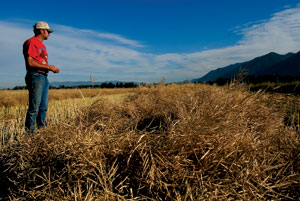The canola bloom is a rite of summer in the Flathead Valley, with pretty yellow fields emerging across the region’s lush farmland. But this annual event, while embraced as customary today, is actually a new phenomenon, at least on such a widespread scale.
Over roughly the past decade, and especially the last five years, Flathead farmers have increasingly looked to canola as both a useful rotation crop and a viable moneymaker, with demand for healthier oils such as canola oil on the rise. It can also be used for biofuels.
 |
|
Doug Manning holds canola seeds harvested at his farm east of Kalispell. |
The spread of canola in Northwest Montana is further encouraged by the region’s close proximity to Canada, a major canola market and home to crushers necessary to make the oil. Canola is traded on a Canadian commodities exchange.
“Canola has been around for a long time, especially in Canada, but it’s just catching on here,” Doug Manning, a local farmer, said.
Miles Passmore has grown canola for six years, not counting an earlier short-lived experiment, qualifying him as one of the more experienced canola producers in the region. He said years ago he and his father tried growing canola, but low prices and lack of experience with the new crop deterred the Passmores.
Today Passmore raises between 300 and 400 acres of canola in the valley.
“Now, with the prices today, it’s actually a worthy crop for us to be growing,” Passmore said.
Canola is recognized most notably by its yellow blooming stage. The yellow blooms then turn into green pods containing small seeds.
“Think about it like a pea pod, but smaller and narrower with seeds that are significantly smaller,” said Markus Braaten, an agronomist with CHS Kalispell.
Last week, Passmore and Manning were in the midst of harvesting – swathing the plants and then picking them up with a combine, during which the “pods are actually thrashed off,” Braaten said. The seeds are then sent to crushers to be made into oil. The nearest crusher is in Lethbridge.
“The crop looks really good right now out there,” Passmore said.
 |
|
Doug Manning stands next to a swath of cut canola east of Kalispell. |
Since canola is a short-season crop, Passmore said colder Canadian farming regions have grown it for years. The crop has several other qualities that Flathead farmers like, Passmore said. For one, he said it’s “Roundup-ready.”
“We can go out there and kill off the weeds without harming the canola,” Passmore said.
Also, Braaten said canola gives farmers “a viable crop rotation, something other than wheat or barley,” that can help “interrupt the pest and disease cycle.”
“There are some distinct agronomic benefits in using canola,” he said.
Across Montana, canola has been grown for some time, as demonstrated by statistics from the National Agricultural Statistics Service (NASS). According to NASS, Montana farmers planted 65,000 acres of canola in 2000. Acreage fell precipitously until reaching a low of 6,500 in 2009. Last year, that number jumped back up to 17,500.
But Mark Lalum, general manager of CHS Kalispell, said canola has only taken off in the Flathead on a significant scale in the past five years or so. He said valley farmers have “always searched for alternative crops” and canola, propelled by a “really strong” market, has now become a viable alternative.
Prices have increased so much in the past several years that, according to NASS, the value of canola in Montana increased from $131 per acre in 2006 up to $346 per acre in 2010.
“Demand is up,” Lalum said. “Now it’s a good, usable crop for us.”